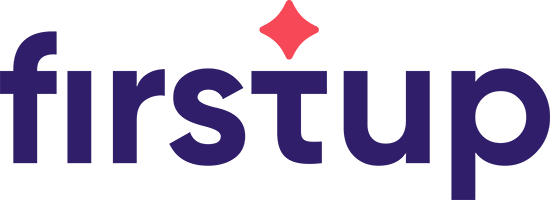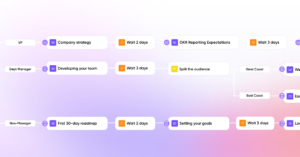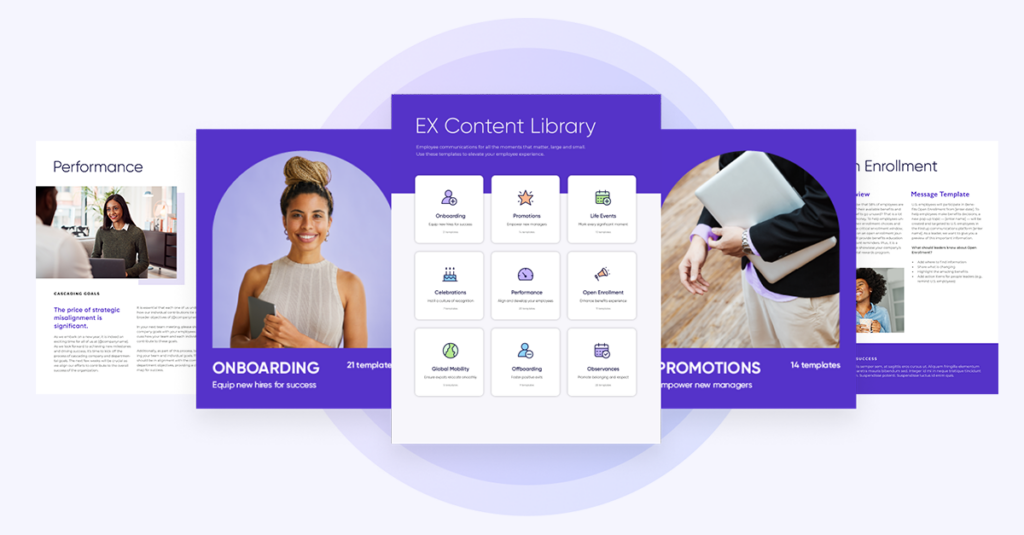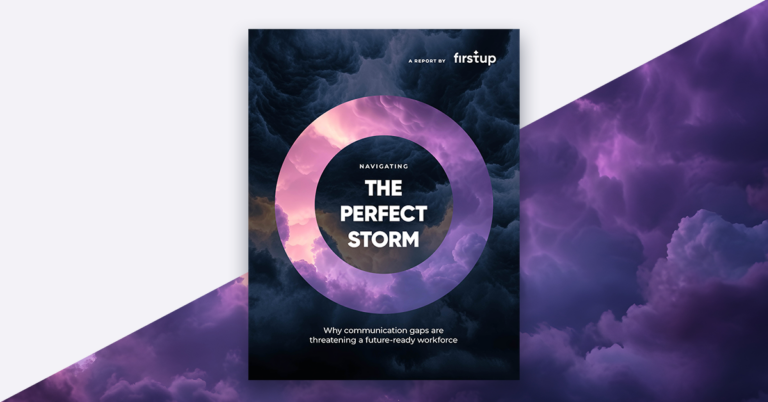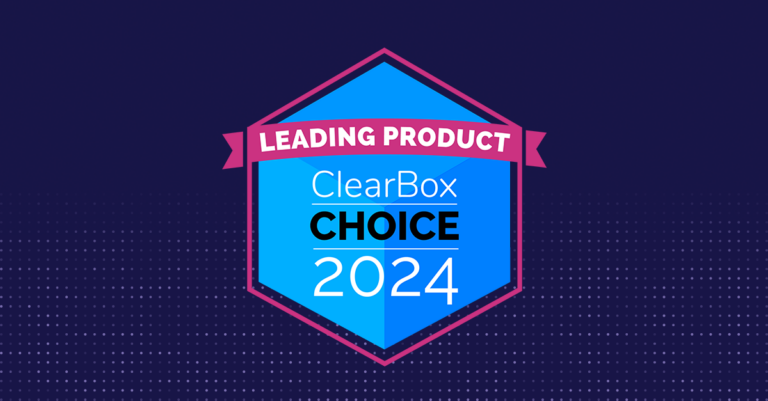This article will tell you what a modern intranet is, but as technologies have evolved, so have the strategies for building an exceptional employee experience. Information should come to employees, not the other way around! The future of communication is employee-centric – you can find out more in this latest article that outlines how a complete intelligent communication platform can be used to deliver this employee-centric approach, with an intranet being a key component. Read More
To deliver an experience that meets the needs of every worker, companies need to take the intranet from employee pain point to agile endpoint—but what does that mean in real terms? Is a modern intranet even enough to digitally transform today’s hybrid workforce? Let’s find out.
Traditional company intranet software remains a roadblock to digital transformation, employee engagement, and achieving performance and productivity goals. Despite their promise, legacy intranets remain a vast repository where company information and resources are difficult to find and maintain, experiences aren’t personalized, and employees quickly become disenchanted.
And while many companies and communication teams now realize they need a more modern version of the intranet to enable the digital workplace, what does that really mean? What does it look like? And is the platform they envision enough to transform how today’s hybrid workforce engages with their employer and teammates?
The intranet as we know it is changing
The intranet has recently gone from an accepted employee pain point to a key corporate priority.
IT leaders, HR professionals, and internal communications teams are trying to figure out how to modernize the corporate intranet to meet the needs of today’s workers, but modernizing outdated technology is only part of the puzzle. Now is the time to go beyond modern intranets to build on the best of what they have to offer and fill the voids where they are lacking.
In this article, we’ll take a closer look at what qualifies as a modern intranet and what other elements are needed to support a successful digital transformation that will help increase employee engagement.
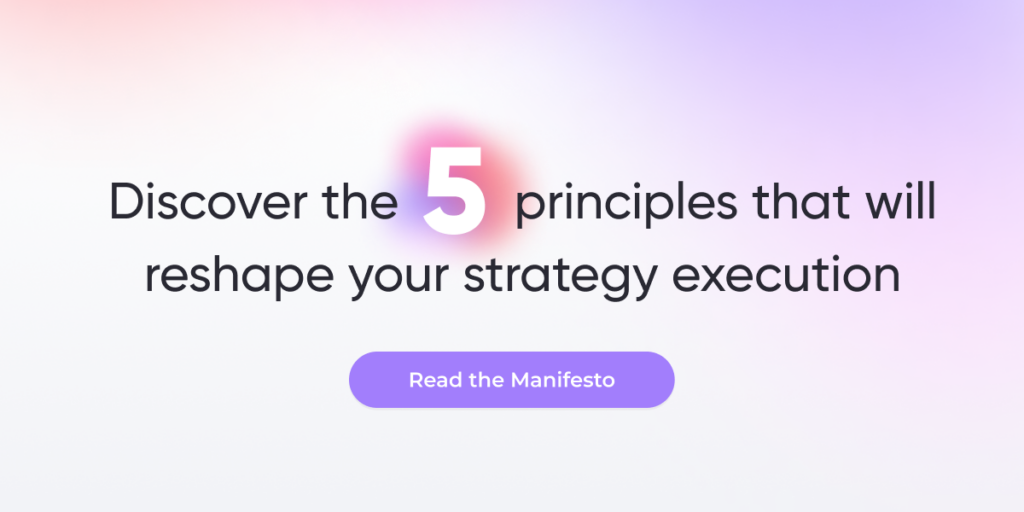
What is a modern intranet?
A modern intranet is the newest iteration of the old-school corporate intranet. Unlike legacy intranet solutions—whose rigid structures force employees to adapt to the technology—modern intranets adapt to the way people work today. They enable employees to access a digital workplace that can be accessed anywhere at any time.
At Firstup, we believe the modern intranet should be a digital front door with many side doors to entry. Modern intranet software should provide a fluid, personalized experience based on an employee’s role, location, and needs. This digital space must allow employees to easily find relevant information and connect to the systems they need to do their jobs for optimum productivity and performance.
By enabling employees to accomplish more with less effort, a modern intranet helps the company become more agile and better achieve its business objectives.
Employees can perform multiple tasks with modern intranets, such as:
- Find documents and resources via their web or mobile browser
- Read and engage with company news personalized to their wants and needs
- Access systems and applications from a centralized source
- Locate subject-matter experts for knowledge sharing
96% of IT leaders say their team is at least partly responsible for improving internal communication and employee engagement.
Pulse Modern Intranet Survey
Traditional intranet vs. modern intranet
Traditional Intranet
-
One gateway to the organization
-
Hierarchical information structure
-
Desktop UX
-
Links out to systems and services
Employee Intranet
Powered by Firstup-
Web and mobile entry points
-
Personalized information structure
-
Consumer UX
-
Integrated systems and services
Characteristics of traditional intranets
The original intranets of the 1990s were on-premises software applications that were costly to implement and difficult to maintain. Companies made large investments in these digital tools and content management systems with few returns.
In the 2000s, software as a service (SaaS) allowed intranet platforms to become more web-based, but they were cumbersome and often still had on-premises elements. For example, when intranet publishing capabilities were first introduced, many enterprises complained of usability issues. Without the ability to easily produce content, employee adoption plummeted.
Over time, corporate intranets were left full of outdated information and broken links, limiting their usefulness. As a content management system, they weren’t user friendly and became known as the place content went to die.
The traditional intranet was designed to be a company’s internal website and network. The primary purpose of a company intranet was to act as a gateway to the organization for desk workers seated at an office computer during the business day.
Features of intranet systems typically included—and usually still include:
- Company news from the internal or employee communications team
- A repository for information and linked resources maintained by the IT department
- Access to an employee directory
- Linked connections to some company systems, such as HR, payroll, and expense reporting
Characteristics of modern intranet systems
While more than 100 vendors in the market claim to be modern intranet solutions, the ones that live up to the category name are those that address the challenges organizations are facing with their traditional intranets.
Modern hybrid workforces work differently than in the past. To qualify as a modern intranet, a technology must:
1. Provide a positive employee experience
Companies need their modern intranet to be easy for workers to use, which means a modern intranet features a user-friendly interface similar to consumer applications.
2. Integrate systems and applications
Modern intranets need to integrate corporate systems, including communication platforms, productivity suites, and collaboration tools such as an employee app to provide a positive user experience.
3. Offer true mobile reach and support
As one of a company’s essential communication tools, intranet software should be available via a native iOS or Android employee app rather than just a mobile web experience.
4. Complement cloud office solutions
Most enterprises have invested in Microsoft 365 or Google Workspace. Many employees spend their workdays in these productivity applications, so a modern intranet must work seamlessly with them for a positive digital employee experience.
5. Offer personalization
Internal communication that’s key to one employee may be spam to another in a different department. A company intranet should personalize the information each user receives as well as the links and applications they can access.
Figure 1: How important are each of the following considerations in a modern intranet?
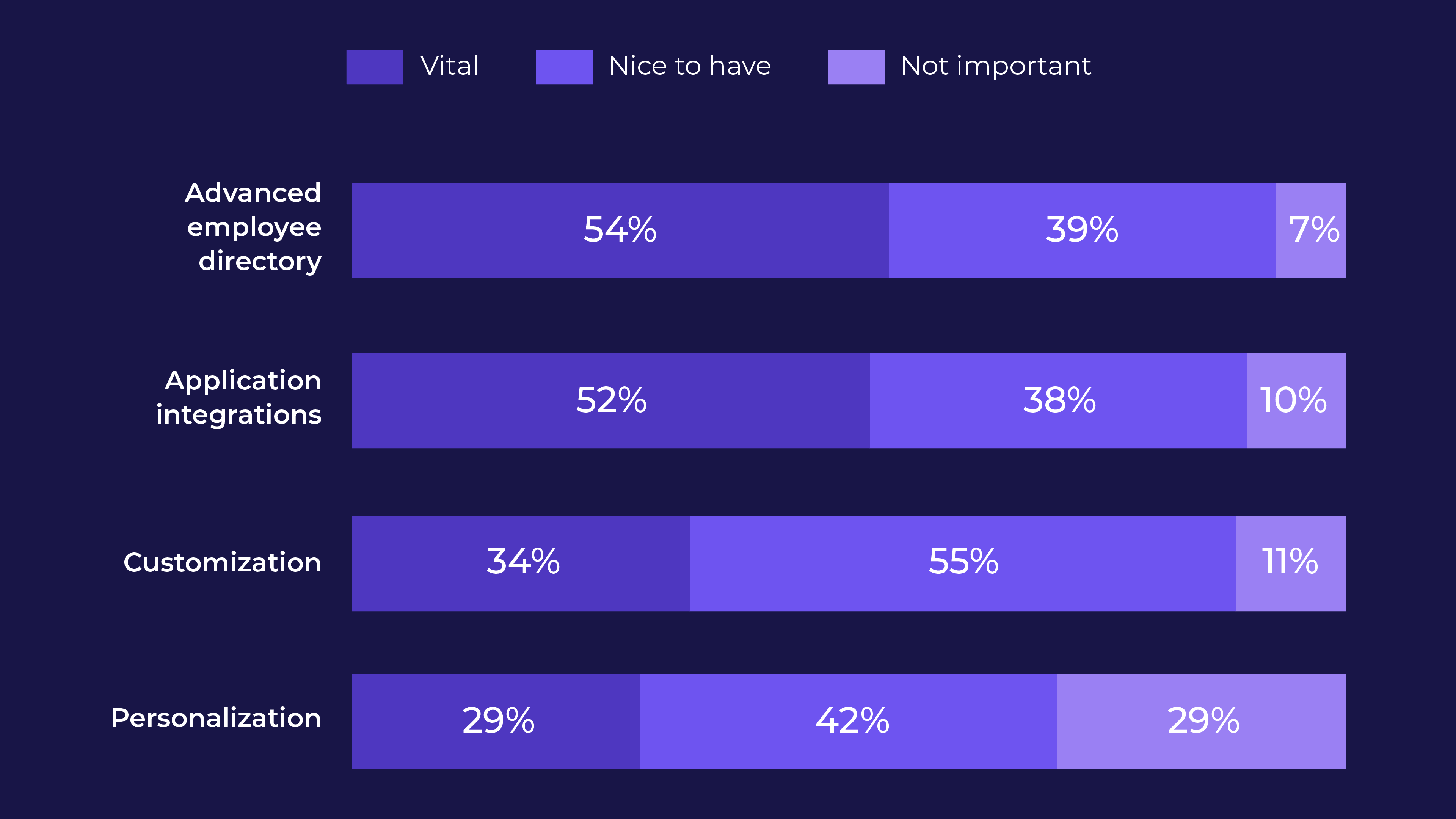
What problems are modern intranets trying to solve?
Enterprises have spent the past decade adding new tools and platforms to their digital workplace in an attempt to improve agility.
The number is staggering: The average company has 254 applications, and, according to Gartner, the average desk worker uses 11 applications to complete their tasks. Because these technologies are often disconnected from each other, they create more barriers for employees rather than enhance productivity.
Source: Pulse and Firstup (IT leader survey: Modernizing your intranet is just the beginning)
The friction caused by these obstacles consumes valuable time in the workweek. Think about how long your average office worker spends trying to find company information or wading through messages and pings from different software.
Alternatively, consider how long it takes a frontline worker—such as those who work in a factory or hospital—to stop their work to check a company system on a desktop computer. These issues continue to proliferate as the workforce becomes more mobile and distributed.
Friction not only makes it take longer for employees to do their jobs, but it can also cause them to miss important company communication and company information, such as new policy changes or business objectives.
Organizations are now trying to modernize their intranet software to address these challenges. Their objective is to give employees one centralized hub they can go to for the information, tools, and company communication they need throughout their workday.
Hyper-personalized comms for every employee
“Our team is learning to consistently allow the Firstup platform to decide on the right time and right place to send notifications. The communicators saw a rapid change in results—sometimes more than double our normal engagement rates.”
Laurie Madden | Senior Advisor, Corporate Communications | Phillips 66
Benefits of a modern intranet
Modern intranets solve the age-old challenge of removing barriers to essential information, company resources, and productivity tools—regardless of the employee’s role, location, or technical skills.
Some of the benefits of a modern intranet include:
1. Improved productivity
Desk-based employees can find what they’re looking for more easily and perform tasks faster, particularly when they use tools in the same ecosystem as the intranet, such as Microsoft 365. On a mobile app, frontline workers can increase efficiency and productivity by having a single point of entry to access the numerous tools and applications they use in a given day.
2. Digital transformation
The modern intranet can help companies promote the adoption of new technologies, essential features, and processes to all of the employees who regularly use this internal website, whether at a desk or on a mobile device.
3. Better collaboration
A modern intranet fosters team collaboration by providing digital tools and platforms that facilitate good internal communication, document sharing, knowledge sharing, and project management. Modern intranets with an employee directory also make it easy to locate subject-matter experts and engage with colleagues—especially for those who work remotely.
4. Greater efficiency working from home
According to Gallup, 8 in 10 remote-capable workers are currently hybrid or remote employees. A company intranet enables a number of these workers to perform the same workflows at home as they would at the office, with effective project management tools and other applications. A positive digital employee experience is crucial to keep these remote workers engaged.
5. Little to no training required
A modern intranet should be easy to manage, design, brand, and maintain. A modern intranet system has user-friendly interfaces, meaning most employees and internal communications teams will be able to navigate the site intuitively and be able to use the full set of features with minimal training.
6. Short launch timeframe
Out-of-the-box modern intranet solutions can be deployed in a matter of days, while a full redesign of a traditional intranet or older internal website may take months to complete. The time saved on such project management can be better invested in implementation and adoption.
55% of HR and comms respondents specifically emphasize the importance of a customized homepage displaying relevant content to unique users. 79% of IT leaders indicate that content integration capability is the most crucial feature, and 79% said an easy-to-use interface is most crucial.
Pulse Modern Intranet Survey
The modern intranet and the employee experience
What part does a modern intranet play in employee experience? In the same way customer experience has been the North Star for many business decisions in the past decade, the employee experience (EX) has become a growing internal priority. Higher employee engagement has a significant impact on customer satisfaction.
If we consider EX the whole of an employee’s experiences with a company, then their digital employee experience (DEX) is the whole of their user experience with the company’s tech stack, employee portal, and other digital tools.
While billions are spent every year on the customer experience, for comms and people leaders, the employee is the customer. Employees are short on time and have multiple demands on their attention, just like consumers.
Consumer brands create a positive user experience to get through to customers despite these issues—and companies now need to take that same step.
2023 Gartner Magic Quadrant for Intranet Packaged Solutions
Learn what the world’s leading research and advisory company has to say about the modern intranet.
While the digital employee experience is a relatively new term, IT, HR, and internal communications leaders have been focused on it for some time. They recognize that employees in various roles use different endpoints and mobile access to do their work, and therefore these employees have varied user experiences.
User experience can vary greatly depending on how the employee consumes information. A wired worker watching a video on their desktop computer won’t have the same experience as a warehouse worker watching it at lunch on their mobile devices.
In the same way, some employees live in their email inbox. Others view email as little more than busy work and live instead in communication tools such as Slack or Microsoft Teams.
Employees aren’t just having different experiences—they’re having different struggles accessing company information. Wired desk workers are inundated with emails and instant messaging in Slack, and they have to manually log into different systems to find the information they need.
Meanwhile, frontline workers, contractors, and other employees without a company email address are often left in an information vacuum because they don’t have login privileges to a user-friendly intranet platform.
Transforming the modern intranet AND the employee experience
Modernizing the digital employee experience means making information and applications accessible for every worker—no matter what systems or endpoints they normally use for work.
It also means giving all employees the same features and functionality.
At Firstup, we call this “unifying the digital experience.”
Giving equal opportunity information access to all workers is a form of employee recognition and acknowledgement of their needs.
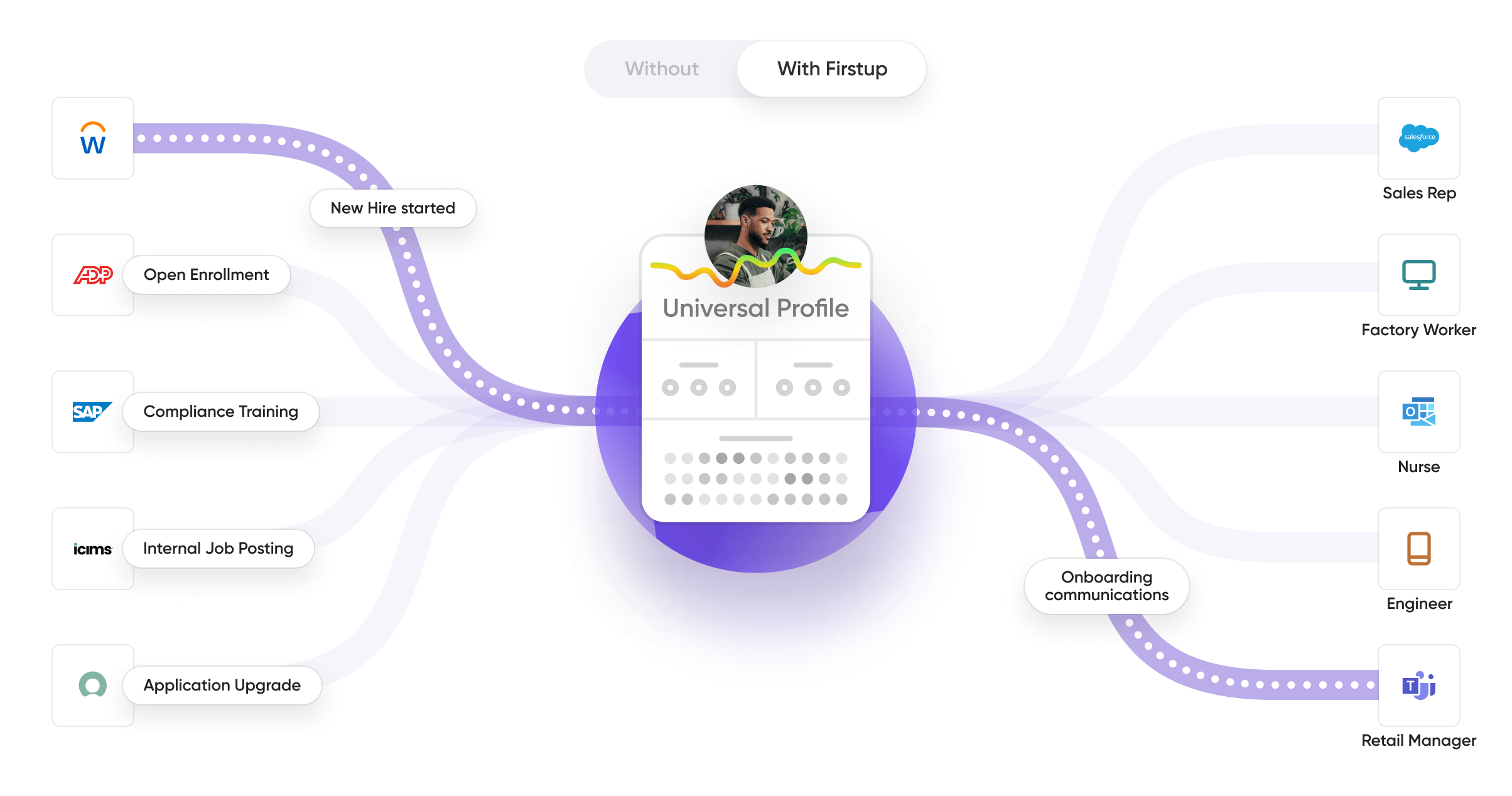
Top 5 benefits of a digital employee experience platform
The benefits of a modern employee experience include better ROI for companies than modernizing the intranet alone. This is important to note, because modernization can require significant budgetary resources to complete, and organizations will want to make sure their budget goes as far as possible. A more holistic modernization can offer:
1. A robust experience for every role
Internal communication applications and document management systems shouldn’t be designed solely for workers at desks. Modernizing your tech stack ensures that every employee in today’s hybrid workforce has an equally effective user experience, including frontline, essential, and distributed workers.
2. Campaign automation and targeting for employee communications
Internal communicators can target content to specific groups or employees, including frontline and deskless workers. They can also set specific goals for their communications and then automate notifications and follow-ups to ensure those goals are achieved—simplifying their workflow and making their messages more effective.
3. Decentralized publishing features
Employees communicate and publish via web and mobile interfaces, so any user can be granted permission to create and post user-generated content, which increases connections and engagement.
4. Multiple methods of deployment and consumption
Users have access to the same content and capabilities across all endpoints and channels, including the corporate destination site, mobile apps, newsfeeds, and company-issued and personal devices. New content and features can be deployed across all of these endpoints.
5. Greater agility for the organization
Not only is the workforce able to be more productive, but companies can get employees to act rapidly during critical organizational changes.
Figure 2: What benefits would you anticipate your organization could derive by adopting a modern intranet tool?
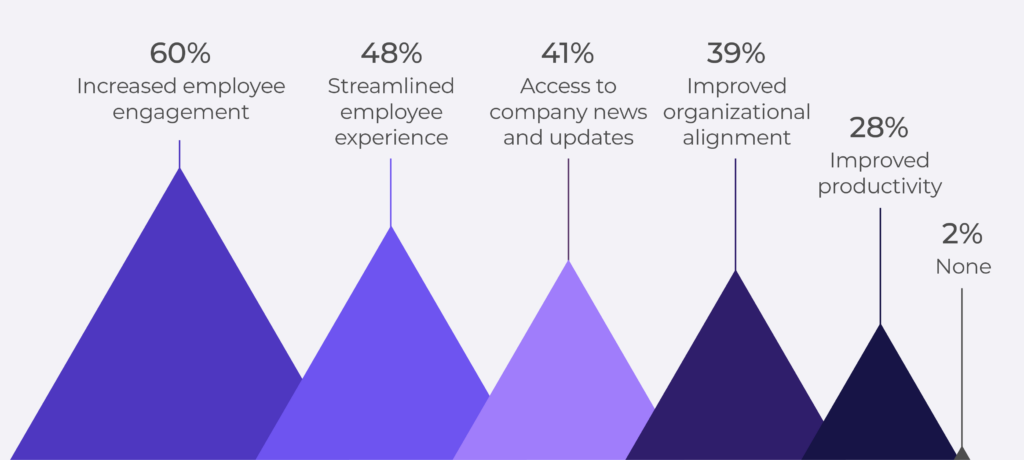
How does a modern intranet and positive digital employee experience impact an organization?
When an enterprise modernizes their existing intranet and employee experience, it creates change across workflows, processes, and corporate systems for better communication and collaboration. Here’s how that can impact some of the most high-priority areas for companies.
1. Employee engagement
Intranet platforms with strong capabilities to personalize communications can boost employee engagement by increasing the relevance of content, links, and apps. The more relevant and important the content is for each user, the more likely they are to engage with it.
For hyper-personalization at scale, however, an enterprise needs advanced targeting features. These will enable the company to personalize by role and location, and also by employees’ interests and preferences, as determined by their behavioral and engagement data.
70% of deskless workers report more technology—including communications, operations and logistics, onboarding, and training—would help them do their jobs better.
Emergence
2. Internal communication
Many older iterations of the intranet had insufficient and ineffective publishing features. A modern intranet should eliminate these challenges for internal communicators and enable them to seamlessly create and publish content.
At a minimum, communicators should be able to publish to the intranet, but a solution that considers the entire digital employee experience should also offer omnichannel publishing. This capability allows communications to be published to every channel and endpoint at once, such as to email, mobile, and collaboration tools.
Omnichannel publishing saves time and simplifies workflow for communicators, while also reaching employees even when they can’t access the intranet.
3. Digital workplace
Modernizing the intranet and the digital employee experience should create cohesion across the digital workplace. On any given day, 78% of employees use six or more tools, channels, and systems just to communicate internally, which 74% of IT leaders agree is too many.
A modern platform makes the digital workplace less fragmented and more streamlined by connecting all of these elements.
4. Digital transformation
When these elements come together, they help accelerate digital transformation because IT teams can then promote adoption across any system, channel, or endpoint employees typically use. And if their communication platform includes unified analytics, they’ll also be able to measure the progress of their transformation by acting on insights provided by communication engagement and other employee behavioral data.
5. Workforce intelligence
How do you know if your employees have read or engaged with your CEO’s latest announcement, particularly if that message was sent to multiple channels?
A unified modern intranet allows you to measure your workforce’s response to content across channels and dig deeper into the trends that actually drive employee engagement. Intelligent communication platforms can also empower you to automate follow-up messages on critical content.
Creating a modern intranet
It’s time for a new era of modern intranets, powered by the Firstup intelligent communication platform. Compared to other intranet tools, rather than just modernizing the intranet, the Firstup intelligent communication platform orchestrates the entire employee experience. This means the modern intranet solution gives every employee the personalized experience that’s just right for them—whether via the web or mobile or within any app or system.
Employees and companies get considerably more out of modernizing the employee experience compared to just modernizing the intranet.
1. Omnichannel entry to the organization
Instead of just a web and mobile “front door” to the company, Firstup creates multiple side doors via any channel or endpoint, including email, mobile, desktop, communication and collaboration tools like Slack, and enterprise systems like Salesforce. Each employee can read from and write to any application or system they use to do their job, right within the platform.
Find out how 365 Orchestration from Firstup can streamline your enterprise communications to reach every employee across all of their Microsoft endpoints
2. Hyper-personalized information sharing
An intelligent communication platform sends information to the endpoints each employee uses most, so workers aren’t forced to search for it on a central hub. A smart inbox and digital assistant prioritize content based on each worker’s needs and role, rather than relying on an unwieldy multilevel folder structure.
3. Intuitive UX and content categorization
Topic pages provide hubs that are easy to create and manage to consolidate and share information pertaining to subjects like HR resources or onboarding processes. The user-friendly interface requires little to no training for employees to access and navigate it.
4. Employee self-services at all endpoints
Workers can find the digital tools and resources they need wherever they’re working. Organizations can set up permissions so certain users can create channels and target content to specific groups.
5. Automation and intelligence
HR and internal comms teams can send communications with key goals, as well as automated follow-ups to prompt users to take action. Unified analytics provide a clear picture of which communications and business initiatives are working.
Conclusion
The workplace of the future looks and operates much differently than how work has been done over the past few decades. Be sure you are prepared to meet the current and future demands of your workforce by implementing a modern intranet that works for every employee no matter their role or preferred endpoint.
Firstup brings the modern intranet to every employee, wherever they are.
Deliver a hyper-personalized employee experience at scale
Download PDF
